Category Archives: Featured
CSW 2025
Youth
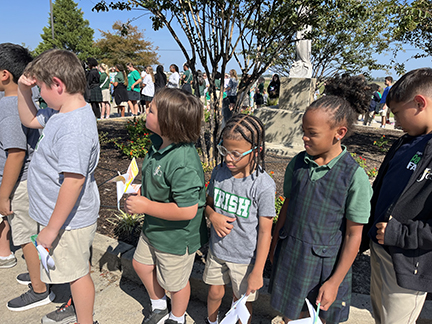
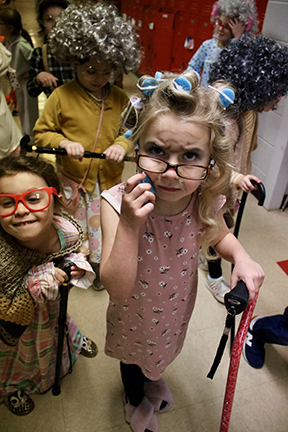
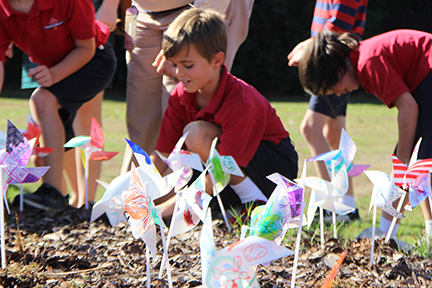
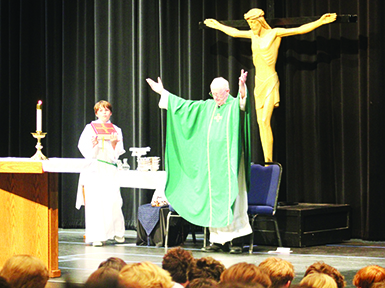
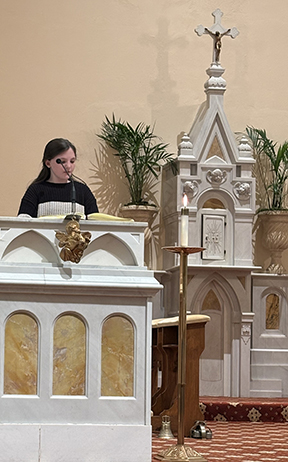
Youth
Youth Photos from Around the Diocese

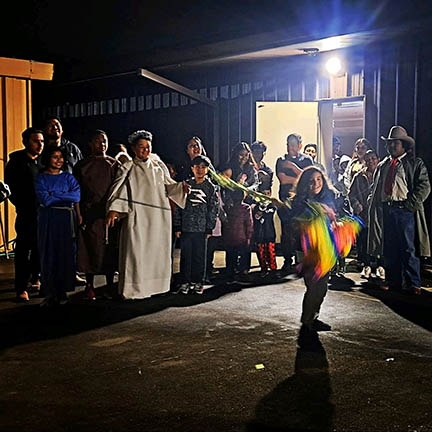
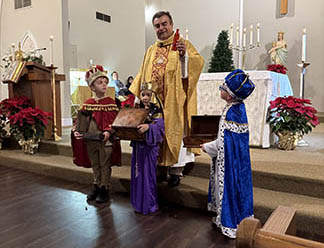
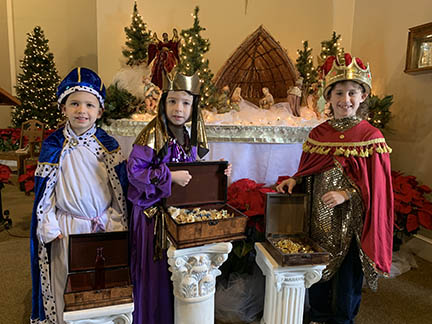
TUPELO – Elementary faith formation students at St. James parish dressed up as the Three Kings who brought gold, frankincense, and myrrh to Jesus. Pictured above are Patton Weatherford in red, Christian Orostico in purple and Thomas Weatherford in blue, with Father Octavio Escobar on Jan. 4. Pictured below are Jones Bridges, Peter Morton and Reagan Burnley on Jan. 5. (Photo by Rhonda R. Swita)
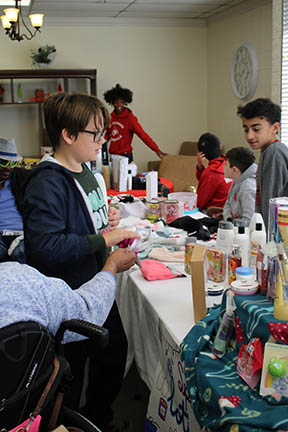


CSA 2024 report
Remembering the 1886 consecration of St. Mary Cathedral
From the Archives
By Mary Woodward
One of the main liturgical events during Bishop Francis Janssens’ tenure (1881-1888) as Bishop of Natchez was the consecration of St. Mary Cathedral now St. Mary Basilica. The construction of St. Mary was begun under Bishop John Joseph Chanche, first bishop of the diocese, in February 1842. For more than 40 years, the building of the original cathedral was carried out. It had been blessed, but it had never been consecrated according to the solemn rites. Church custom at that time was a church would not be consecrated until it was debt free.
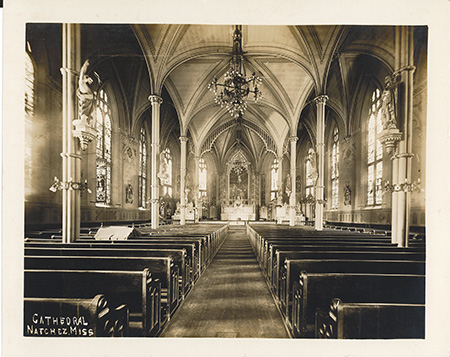
At times during these 40 years, construction stalled, bank foreclosure loomed, and cows roamed freely in it. Even under the long term of Bishop William Henry Elder, the church had a debt. It was under Bishop Janssens that the debt was paid and on Sept. 19, 1886, the cathedral was consecrated.
A friend and fellow history lover and I were talking the other day about the beauty of the English language during the 19th century, so I will let the melodic phrasing of Brother Celestin, a Sacred Heart Brother and teacher at Cathedral School in Natchez describe the events of the day:
“At an early hour Sunday, Sept. 19th, 1886, the Feast of the Seven Dolors of the Blessed Virgin Mary, the Rt. Rev. Bishop of the Diocese, Francis Janssens, assisted by many of the diocesan clergy, began the consecration of the Cathedral and its main altar.
“Within the altar-stone was placed a tin box enclosing the relics of the martyrs, Sts. Victor, Innocentus and Celestinius and a parchment thus inscribed in Latin: ‘In the year, 1886, the 19th of September, I, Francis Janssens, Bishop of Natchez, have consecrated the Church and this altar in honor of the Transfixed Heart of the ever blessed and immaculate Virgin Mary, and have enclosed the relics of Martyrs and have granted in the usual form of the Church, an indulgence of one year this day and on each anniversary of the consecration an indulgence of forty days to all the faithful of Christ visiting the Church’.
“At half past ten o’clock a procession was formed at the Episcopal residence, headed by Cross-bearer and Acolytes, and followed by all the children of the schools and asylums with their banners and oriflammes, all the priests who had assisted at the Synod, the Rt. Rev. Bishops O’Sullivan of Mobile, Becker, of Savannah, the Ordinary of the Diocese, the Most Rev. Archbishop of the Province, Mgr. Leray of New Orleans, and the venerable Archbishop Elder, of Cincinnati, formerly of Natchez, who was to officiate at the Pontifical Mass.
“The church was crowded with Catholics and non-Catholics, many of whom came from a distance, and the desire to witness the grand ceremonies was so great that fully 1,250 persons admitted by tickets filled the sitting and standing room of the spacious building.
“After the Gospel, the Rt. Rev. T. A. Becker, of Savannah, ascended the pulpit, and choosing his text from that part of the I Book of Kings, descriptive of the dedication of the Temple of Solomon, said that many distinguished prelates some from contiguous dioceses and some from afar had come to form with them a triple alliance to show veneration and regard for this august ceremony, to venerate and respect the sublime ceremonial of the church that they had just witnessed, which the more it is studied the more admired, and lastly to congratulate them on the perfection of the grand work done under their auspices and of those who rule over them in the Lord.
“The Catholic Church, he said, was One, Holy, Catholic and Apostolic. One in her essence and unity, Holy in her doctrines and truth, Apostolic because she can trace her descent and priesthood back to the unlearned men who received the divine commission, ‘Go, teach ye all nations.’ Had anyone lived four centuries or a thousand years ago he could have been nothing but a Catholic, for then there was no other religion. She is Catholic. She is not the Church of England, or France, or Germany or of the United States, but the Church of the living God and as such is reverenced by the greatest intellects of the age.
“In conclusion he hoped that the memory of this glorious day would ever be green, and that each recurring anniversary may bring down blessings from on high, and that each may say, ‘I believe in the One, Holy, Catholic, Apostolic Church.’
“In the afternoon, Most Rev. Archbishop Leray, of New Orleans, the last priest ordained in the Cathedral by Bishop Chanche, sang Pontifical Vespers. Before solemn Benediction, Archbishop Elder, in some feeling words, addressed the large congregation. He said ‘that he beheld a holy city decked like a bride going to meet her spouse.’ Such was this church to him.
“He spoke of the charity of many who had generously assisted in the works of zeal and benevolence. Let there be no limit to joy and to gratitude but let us not forget those that are gone; on such an occasion we remember the absent and the gaps made by death, but, said he, let us remember God loves our tears and that there is a place where all tears are wiped away. This consecration is an emblem of the Kingdom of Heaven. May all who are here present be gathered there at the end and may the dear departed not be wanting.
“With the evening Angelus Bell passed away the last ceremonies of the sacred Consecration leaving a church sanctified and holy and on the minds of the privileged beholders, a memory sweet enough to linger many a day.”
Tune in next time for more From the Archives.
(Mary Woodward is Chancellor and Archivist for the Diocese of Jackson.)
Youth
Around the diocese
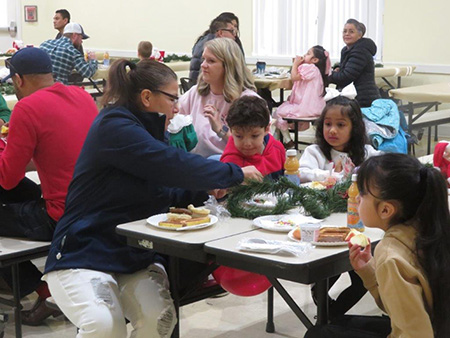
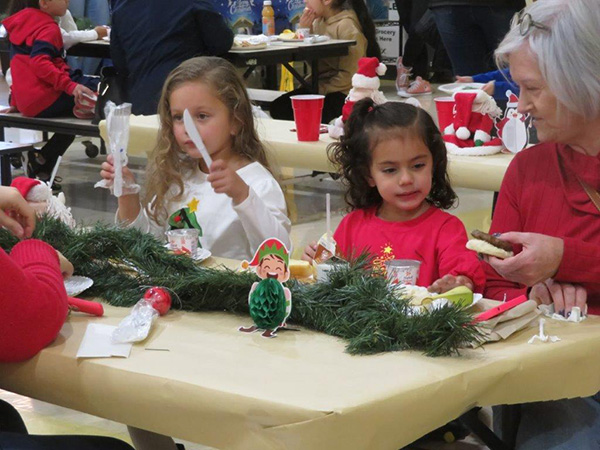
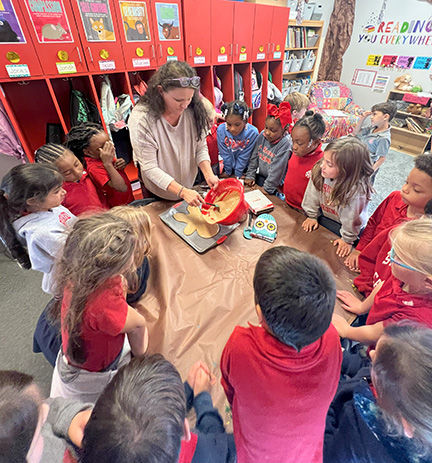
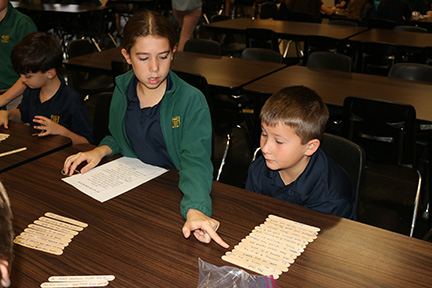
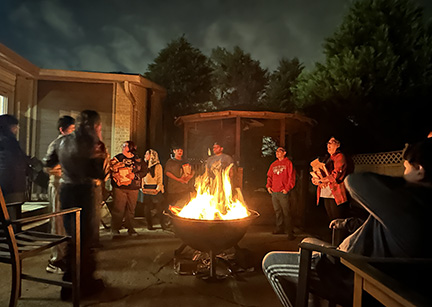
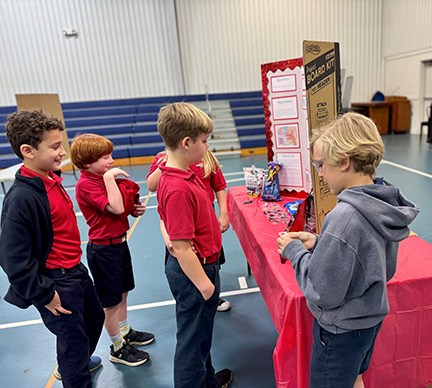

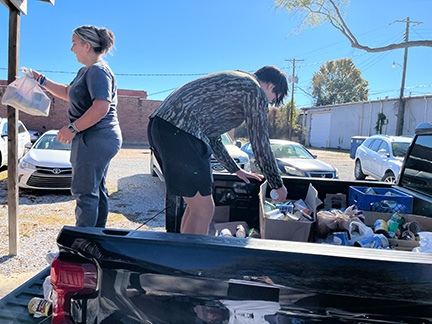
GREENVILLE – (Above) St. Joseph students, Cadence McDonald, Malorie Lockett and Kimberly Holland help organize canned goods donated for Thanksgiving. (Left) CJ Martinek and Jay Chow help unload a truck full of canned goods for the St. Vincent de Paul food drive. (Photos by Nikki Thompson)

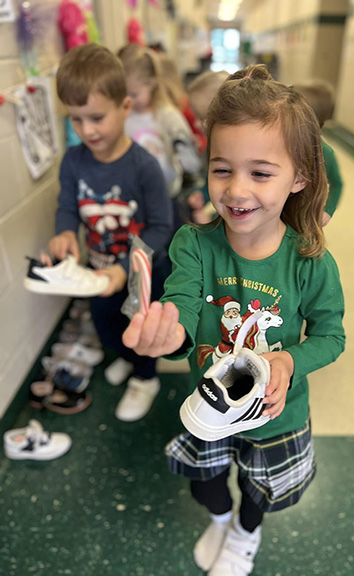
Mississippi Catholic
December 20
Diciembre 20
December 6
Diciembre 6
November 22
Noiembre 22
November 8
Noviembre 8
October 25
Octubre 25
October 11
Octubre 11
September 27
Septiembre 27
September 13
Septiembre 13
August 23
23 de agosto
July 19
19 de julio
June 14
14 de junio
May 24, 2024
24 de mayo, 2024
May 10, 2024
10 de mayo, 2024
April 26, 2024
Abril 26, 2024
April 12, 2024
Abril 12, 2024
March 22, 2024
Marzo 22, 2024
March 8, 2024
Marzo 8, 2024
Feb. 23, 2024
Febrero 23, 2024
February 9, 2024
9 de febrero, 2024
January 26, 2024
Enero 26, 2024
January 12, 2024
Enero 12, 2024
December 22
Diciembre 22
December 8
Diciembre 8
November 22
Noviembre 22
November 10
Noviembre 10
October 27
Octubre 27
October 13
Octubre 12
September 29
Septiembre 29
September 15
Septiembre 15
August 25
Agosto 25
July 21
Julio 21
June 23
Junio 23
May 19
Mayo 19
May 5
Mayo 5
April 21
Abril 21
April 7
Abril 7
March 24
Marzo 24
March 10
Marzo 10
February 24
febreno 24
February 10
febreno 10
January 27
27 de enero
January 13
13 de enero
December 23
23 de diciembre
December 9
9 de diciembre
November 25
25 de noviembre
November 11
11 de noviembre
October 28
28 de octubre
October 14
14 de octubre
September 30
Septiembre 30
September 16
Septiembre 16
August 19
Agosto 19
July 15
Julio 15
Junio 17
May 27
Mayo 27
May 13
April 29
Abril 29
April 15
March 25
25 de marzo
March 11
February 25
25 de febrero
February 11
January 28
January 28 28 de enero
January 14, 2022
December 17
17 de diciembre
December 3
November 19
19 de noviembre
November 5
October 22
22 de octubre
October 8, 2021
September 24
24 de septembre
September 10
August 20
Back 2 school
20 de agosto
Bishop Joseph N. Latino in memoriam
July 16, 2021
16 de julio de 2021
June 18, 2021
18 de junio de 2021
May 28, 2021
28 de mayo de 2021
May 14, 2021
April 30, 2021
30 de abril de 2021
April 16, 2021
March 26, 2021
26 de marzo, 2021
March 12, 2021
February 26, 2021
26 de febrero de 2021
February 12, 2021
January 29, 2021
29 de enero de 2021
January 15, 2021
December 24, 2020
24 de diciembre de 2020
December 11, 2020
November 20, 2020
20 de noviembre de 2020
November 6, 2020
October 23, 2020
Espanol 23 de octubre de 2020
October 9, 2020
September 25, 2020
25 de septiembre de 2020
September 11, 2020
August 28, 2020
August 14, 2020
Youth
Around the diocese … and beyond
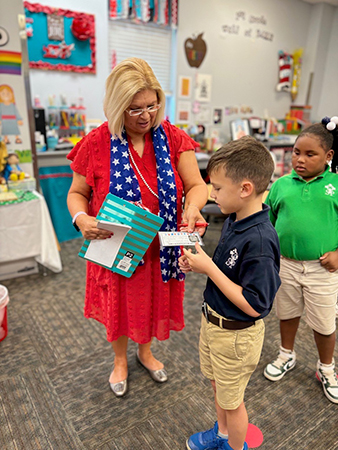
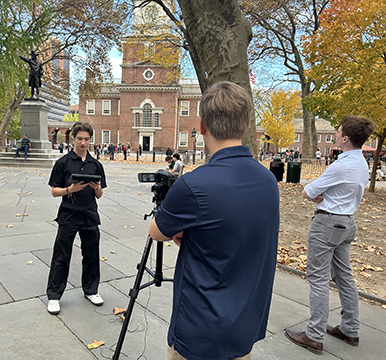
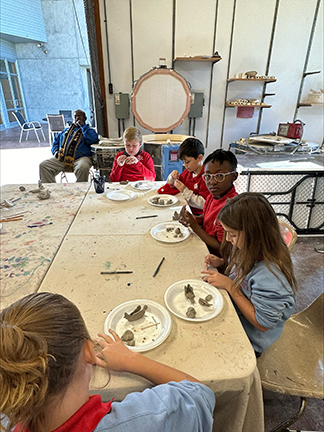
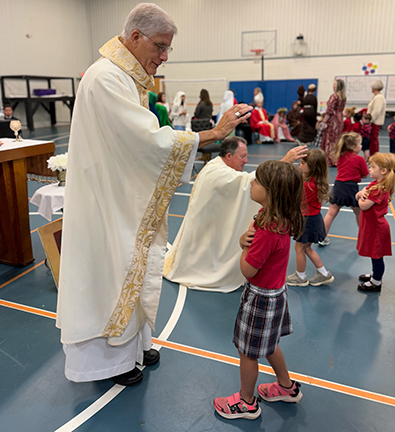
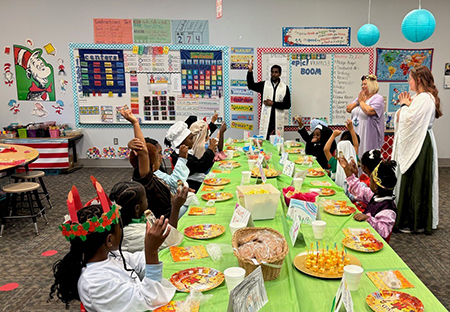
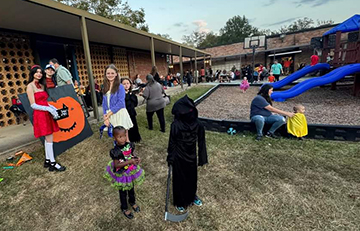
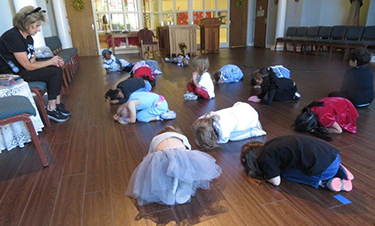

Holy Family School marks 75 years of faith, education and service
By Laura Grisham
HOLLY SPRINGS – Holy Family School recently celebrated its 75th anniversary with a three-day event filled with faith, fellowship and festivities. The school, a cornerstone of Catholic education in the region, has evolved from its beginnings as St. Mary’s School in 1948 to Cadet in 1969, and finally Holy Family in 1994.
The celebration began with a special Mass led by Bishop Joseph Kopacz. He was joined by SCJ Fathers Jack Kurps, Vien Nguyen, David Szatkowski and Guy Blair as co-celebrants. The Mass, enhanced by the angelic voices of St. Mary’s choir, set a reverent tone for the festive weekend.
Bishop Kopacz’s homily highlighted the school’s journey and the enduring contributions of its educators. “For 75 years, teachers, administrators and community leaders at Holy Family School have embodied the mind and heart of Christ, serving as beacons of hope and faith for students and families,” he said.
Drawing on the words of St. Paul, the Bishop celebrated the gifts of teaching, prophecy and service in the community of faith. He also tied the celebration to the upcoming Jubilee Year of Hope, declared by Pope Francis for 2025. “Rejoice in hope, persevere in affliction, and be faithful in prayer,” he urged attendees, calling the milestone a testament to faith and resilience.

The festivities reflected the vibrancy of Holy Family’s legacy. Alumni traveled from as far as Alaska, Michigan and Illinois to reconnect and reminisce. St. Mary’s School alumni gathered to sing their school song, “The Bells of St. Mary’s,” rekindling fond memories.
Despite the dreary weather, celebration was attended by Holy Family students and parents, school alumni and people from across the Marshall County community. Throughout the weekend, participants enjoyed a mix of family-friendly activities, including performances by the students, basketball scrimmages, a bazaar, carnival games, a cake walk, grab bags, bingo and a silent auction. The celebration also featured a catered alumni dinner and dance, bringing together past and present members of the school community.
A Legacy of Service
Holy Family School’s story is one of adaptation and commitment to its mission. When it opened in 1948 as St. Mary’s School, it served 55 students across eight grades with just one teacher. The following year, enrollment grew, aided by the arrival of four School Sisters of St. Francis. By 1950, a high school was added, accommodating the rhythms of the cotton harvest by pausing classes in autumn.
In 1969, the school merged with St. Joseph School to become CADET (Christian Aided Development Through Extraordinary Training). In 1994, it adopted the name Holy Family to honor its Catholic roots and its dedication to serving children and families in Holly Springs.
Honoring Staff
Several staff members were recognized for their tenure and enduring commitment to the school, including Holy Family’s new principal, Cynthia Dixon, school secretary Cathy Walker (45 years) and teachers Artheria Relliford (35 years), Shirley Daugherty (50 years) and Srs. Julene Stromberg and Ramona Schmidknecht, OSFs, (retired).
As part of the anniversary, the Marshall County Board of Supervisors passed a resolution honoring Sister Ramona Schmidknecht, OSF, for her 56 years of service as an educator at St. Mary’s, CADET, and Holy Family School and 61 years of service to the Marshall County community.
Looking Ahead
Bishop Kopacz concluded his remarks by reflecting on the Sacred Heart of Jesus as a model for the community.
“May we strive to beat with the heart of Christ and serve with His mind,” he said, adding his hope that Holy Family’s legacy will endure for another 75 years.
With its rich history and unwavering mission, Holy Family School remains a beacon of hope, faith and service in Holly Springs and beyond.
(Laura Grisham is the PR and Communications manager for Sacred Heart Southern Missions in Walls, Mississippi.)
